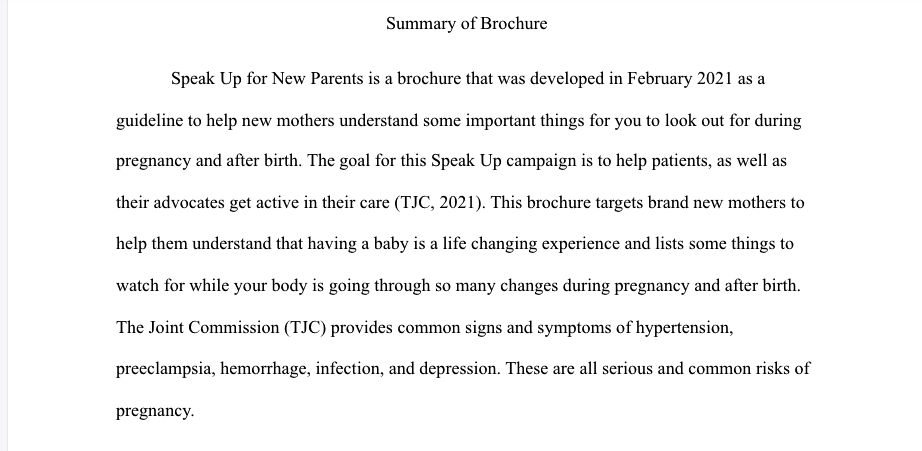NR-224 RUA Safety Goals Assignment
31 May 2024Get your Online class for NRR224 be done by experts on your behalf. Contact us Here
RUA: Safety Goals Assignment
Marissa Daniels
Chamberlain University
NR224: Fundamentals: Skills
Professor Stacey Hobbick
August 15, 2021
Summary of Brochure
Speak Up for New Parents is a brochure that was developed in February 2021 as a guideline to help new mothers understand some important things for you to look out for during pregnancy and after birth. The goal for this Speak Up campaign is to help patients, as well as their advocates get active in their care (TJC, 2021). This brochure targets brand new mothers to help them understand that having a baby is a life changing experience and lists some things to watch for while your body is going through so many changes during pregnancy and after birth. The Joint Commission (TJC) provides common signs and symptoms of hypertension, preeclampsia, hemorrhage, infection, and depression. These are all serious and common risks of pregnancy.
Communication
TJC communicates with the audience what to do to prevent some of these things from happening and what to do if you experience any of these things. For example, TJC listed common signs and symptoms for preeclampsia and hypertension and then gave some tips. Those tips are as followed: “never miss a prenatal visit, be sure your OB provider checks your urine for protein, keep a record of your blood pressure so you will know if it changes, count your baby’s kicks (TJC, 2021).” A common tip throughout the brochure is open communication. For preeclampsia and hypertension, the brochure says to contact your OB if you do not feel your baby moving like normal. The normal amount of movement should be about 10 kicks per hour. For signs of hemorrhage, it states to communicate with your OB if you are anemic or have had any blood problems in the past. For infection, the brochure says to ask visitors to wash their hands. Lastly, the brochure mentions to let your OB provider know if you are experiencing any difficultly eating or sleeping, feelings of helplessness or sadness, not wanting to get out of bed, avoiding contact or bonding with your baby, or thoughts of wanting to harm yourself (TJC, 2021). Open communication is the best way to make sure you are decreasing your chances of these serious pregnancy complications.
Personal Reflection
Pregnancy complications are an important topic that should be talked about more frequently. Although, nobody wants to discuss any kind of complications because they are scary it is important to be educated about any possibilities that could happen. Personally, I loved being pregnant, but it was scary because it was a whole new territory and something my body had not yet been through. My pregnancies were not complicated, but I do remember having some difficult conversations with my husband during pregnancy and making plans for a “just incase this happens, this is what we will do.” Luckily, we did not have to put any of our plans into action. During pregnancy, it is important to communicate with those around you who advocate for you (family, friends, whoever that may be) and your healthcare providers so that they can help you if or when you need it. They are not mind readers though, so if there is not an open line of communication, then they will not know that you need help at all.
Evaluation of Brochure
This brochure has information that is very beneficial for pregnant patients. As a future labor and delivery nurse, this information will be something I pass on to my patients. TJC did a great job clearly breaking down what to look for in the different complications and giving tips for patients. However, I do feel like the brochure had too many words. The few pictures that are on the brochure are small and not very attention grabbing. I think they could have added some more pictures to make it “flashier” to grab the attention of the audience. The information provided in this brochure is supported by current nursing/medical journals which makes these claims evidence based. As mentioned earlier, this brochure is targeted towards new mothers but is great for seasoned mothers as well. Especially, because not all women have their babies backto-back. Some women have big age gaps between their children, so this brochure would be great for those women as well because these are risks they may have forgotten about since their last baby.
Evidence Review & Application
According to Ghaedrahmati et. al, postpartum depression is a high prevalence mental disorder. They mention that postpartum depression could be associated with obstetrical history such as hypertension and preeclampsia (Ghaedramhmati et. al, 2017). Making this brochure more important for pregnant women.
Conclusion
Overall, pregnancy to new mothers is terrifying because it is an entirely new experience, but it is important to talk about those common complications to help prevent them. Some of the major pregnancy complications are hypertension and preeclampsia, hemorrhage, infection, and postpartum depression. The best way to combat these problems is to have open communication with your close friends, family, spouse, and healthcare providers so that they can help. Following the brochure and communicating with your healthcare provider when things do not seem right ill help to decrease those at risk for any of these complications.
References
Ghaedrahmati, M., Kazemi, A., Kheirabadi, G., Ebrahimi, A., & Bahrami, M. (2017).
Postpartum depression risk factors: A narrative review. Journal of education and health promotion, 6, 60. https://doi.org/10.4103/jehp.jehp_9_16
The Joint Commission. (2021). Speak Up for New Parents [Brochure]. Author. Retrieved from https://www.jointcommission.org/-/media/tjc/documents/resources/speak-up/speak-upfor-new-parents-85-x-14.pdf


